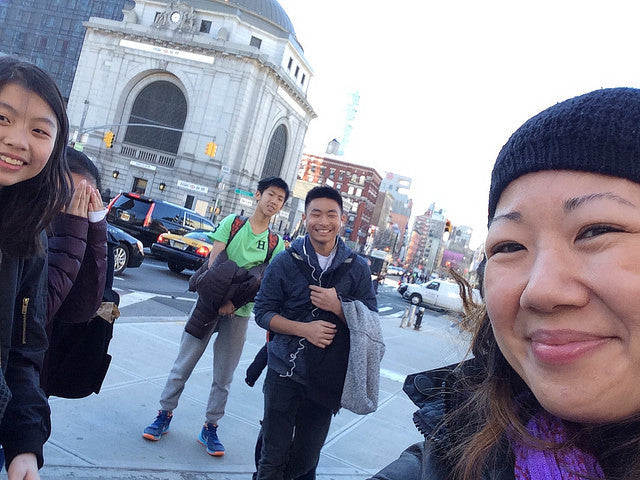
A Talk with E-Anna Soong, the Educator behind 'East Meets West: A Look into Our Worlds'
What happens when east meets west? When English meets Mandarin? When childhood meets adulthood? When old meets new?
Twenty-eight promising student artists of E-Anna Soong's after-school Apex for Youth Art Portfolio program have created an installation of conceptual sculptures, paintings, and prints that explore what living in multiple worlds means to them. Individually, the students offer personal artifacts and artworks, representing their perspectives on being the children of immigrants, immigration in general, and the future.
E-Anna is an artist and formally trained in graphic design and photography, but creates art in various media. She’s also a visual arts teacher for Shuang Wen, a public dual language elementary and middle school.
We had the chance to speak to E-Anna about the program, the pressures some of her students face, and the importance of articulating one’s passion, even beyond one’s art.
How long have you been involved with the program?
I started the Art Portfolio program on my own when I first started teaching at Shuang Wen eight years ago. I teach kindergarten through eighth grade during the day. Then Apex for Youth came on board and that’s made organizing my art program much easier. This Art Portfolio program for Apex has been running for the past three years.
How does the after school program work?
The students are handpicked by me or they’ve told me they wanted to participate in the Art Portfolio program. It’s for my advanced students or those who want to be more skilled in the visual arts. But it’s mainly for the middle school students who want to apply for a specialized arts high school by the fall of eighth grade. Schools like Laguardia High School [of Music & Art and Performing Arts] or Frank Sinatra [School of the Arts].
They essentially need to audition to get into the school. They need a portfolio with 12 to 15 pieces in various media. Portrait, still life, landscape. From observation and from imagination. There's also a drawing test, interview, and/or essay, but usually if they put in the work for their art portfolio, it helps prepare them for the drawing tests on the day of the audition.
Some of the kids don’t necessarily want to put together a portfolio. Some just want to improve in a certain technique, and some are trying to be more creative independently. With those kids, I have to let them loose. You can’t confine them to a certain project. They need the time to explore on their own with some guidance.
Those who plan to apply to arts specialized high schools need a lot more structure. We work with different themes and subject matters using pencil, paint, oil pastel, watercolor, and various materials. I have models who come in and sit for my class. Sometimes family members, friends, or teachers, and even the students themselves model when we need it. That’s in preparation for the drawing test. You have to draw a live human figure within a certain amount of time.
But it’s not all about technique. The eighth graders audition in the fall so we have to make sure they’re ready for that. But it’s looser near the end of the year. We have more crafty projects. For instance, some students love making things with duct tape. I would love to have time to include more photography, animation, and graphic design. Each student has his or her own strong point. Another student might be most comfortable with watercolors, while another may excel at building objects and more hands-on projects, like we did with the paper mâché sculptures in our exhibition.
They each tell me a little about themselves through those materials. They show me what they’re strong at.
Trying to get into Laguardia and Frank Sinatra seems tough!
Yes, it's essentially much like applying college. Maybe even harder. The whole application process can be intense. I've had many talks with my eighth graders and tell them, “Just breathe.”
Middle school kids go through a lot of stress. When acceptances — and rejections — come out, you have a lot of kids crying and extremely emotional. These kids are under a lot of pressure, sometimes from their parents, most of whom are recent immigrants. Some don’t even want the kids to go to specialized arts school. They have this idea of starving artists who can’t support themselves.
Do you ever encounter any parents who refuse to let their kids go to an arts school?
There’s usually at least one every year. I tend to have a conversation that reminds parents there are many careers out there related to the arts and many jobs that require a foundation in the arts. Not just fine art or painting. With some students who have a true passion in the arts, I really do push their parents to understand the arts is something that creates happiness in their child. If the arts is one of the main subjects their child excels in and loves, I hope they realize they should let their child try to find what they enjoy most in life. They're still so young to have to determine what their careers will be. But most parents want their kids to follow the dream they had for themselves and not their child's, which is often typical.
I experienced the same thing with my own parents. They wanted me to find a better life than what they had, and of course that meant becoming a lawyer or doctor. But there are engineers who use the arts in their work. For instance, industrial engineers and package designers. Many parents just have to know about some of these careers and that there are jobs out there they might not have realized require some arts background or those that are not solely art-related.
I try to convince them to at least let the children try to apply. If they have the time to work on a portfolio, at least let them try. If the parents feel the kids don’t have time to work on portfolio, then I can’t do anything about it. If this child has the drive or passion in the arts or they already have the skills, at least let them work on their portfolio. Many of them can do the work and put time into it, if they're supported in school and home. It requires a lot of devoted time to work and I can't provide it all for them. I can just give them the start and guidance, but a lot needs to be done on their own too.
I have to ease parents’ minds. These specialized art schools aren’t just about making art. They have all the core classes. It’s just that the art classes are more advanced, and the kids will have arts classes all four years of high school, unlike other high schools that aren't specialized in the arts. For many schools in New York, ninth and 10th graders don’t even have arts classes. Most only have them in the 11th and 12th grades, if any.
The arts is actually needed to use the other side of your brain and requires a lot of problem solving when it comes to using a material to create the outcome and vision you want.
It must be hard for some of the kids to go against what their parents want.
Yes, but if the kids really want to go to a specialized art high school, they just have to express to their parents that they really want it. Often the parents don’t even know. They sometimes ask me to ask their child if they're interested because they have no idea. And often once they're aware, they’ll actually say, “Okay, I’ll let you try.”
This is good practice for the kids because they have to convince the interviewer they want it. They have to show a passion for the arts in person or in writing. And they have to show the same passion to their parents.
Sometimes I have students who don't apply and wished they had. Ninth and 10th graders come back to me and feel really sad they didn't go through with it when they had the chance. I don’t want them to have regrets like that. I encourage them to try and apply. Even if they don’t get in, at least they know they tried. And they can apply again in 10th grade if they really want it enough to transfer.
Can you tell me a little bit about the exhibit?
It began after speaking with Joanne, the president of Pearl River, at the Lunar New Year exhibition. I was very excited to see the new store had a gallery space for art. When we met, we talked about a future exhibit. It was perfect! I wanted this space for my students.
They all brainstormed ideas of what could we fill in this gallery space. Not just in two dimensions but in three, because we have a room to fill and not just walls.
While all the students are learning Mandarin, they’re not all Asian American. We have an Arab American student, someone who’s half Chinese and half white, another who’s half Chinese, half Japanese. But all their parents are immigrants, and every student speaks both Mandarin and English, and maybe even other languages, too.
They have their own views of what is Asian. I asked them, “What do we think of when we think of Asia?” They’ve taken classes on Chinese culture and art (in third grade). They’ve learned about China and ancient world cultures (in sixth grade). They know a little bit about Asian culture, but what do they actually think about it? Their parents came from a place some of them may have visited or lived for a short period, but we all live here in New York City. How can we create an installation about us, as a group of multi-lingual artists of many backgrounds living in the city?
That’s where the idea of the koi pond and cherry blossom tree came from juxtaposed against a cityscape. The idea of what’s Asian and where they live. Their home.
Want to learn more about the students? Check out what they have to say in their own words.
East Meets West is on display in our mezzanine gallery from May 20 through July 30.
(Interview conducted by Angela Tung)
